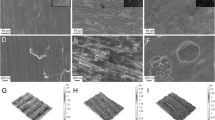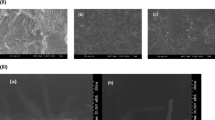Abstract
To investigate in vitro cellular cytokine expression in relation to commercially pure titanium discs, comparing a native surface to a fluorinated oxide nanotube surface. Control samples pure titanium discs with a homogenous wave of the margins and grooves and an often smeared-out surface structure. Test samples pure titanium discs with a fluorinated titanium oxide chemistry and surface morphology with nanopore/tube geometry characterized by ordered structures of nanotubes with a diameter of ≈120 nm, a spacing of ≈30 nm, and a wall thickness of ≈10 nm. Cross-section view showed vertically aligned nanotubes with similar lengths of ≈700 nm. Peripheral blood mononuclear leucocytes were cultured for 1, 3, and 6 days according to standard procedures. BioPlex Pro™ assays were used for analysis and detection of cytokines. Selected inflammatory cytokines are reported. A pronounced difference in production of the inflammatogenic cytokines was observed. Leucocytes exposed to control coins produced significantly more TNF-α, IL-1ß, and IL-6 than the test nanotube coins. The effect on the TH2 cytokine IL-4 was less pronounced at day 6 compared to days 1 and 3, and slightly higher expressed on the control coins. The morphology and surface chemistry of the titanium surface have a profound impact on basic cytokine production in vitro. Within the limitations of the present study, it seems that the fluorinated oxide nanotube surface results in a lower inflammatory response compared to a rather flat surface that seems to favour inflammation.




Similar content being viewed by others
References
Sul Y-T, Johansson CB, Petronis S, Krozer A, Jeong Y, Wennerberg A, Albrektsson T. Characteristics of the surface oxides on turned and electrochemically oxidized pure titanium implants up to dielectric breakdown: the oxide thickness, micropore configurations, surface roughness, crystal structure and chemical composition. Biomaterials. 2002;23:491–501.
Hunt JA, Abrams K, Williams DF. Modelling the pattern of cell distribution around implanted materials. Anal Chem Pathol. 1994;7:43–52.
Moucha CS, Einhorn TA. Enhancement of skeletal repair. In: Browner BD, Jupiter JB, Levine AM, Trafton PG, editors. Skeletal trauma. Philadelphia: WB Saunders; 2003. p. 639–59.
Marsell R, Einhorn TA. The biology of fracture healing. Injury. 2011;42(2011):551–5.
Tsiridis E, Upadhyay N, Giannoudis P. Molecular aspects of fracture healing: which are the important molecules? Injury. 2007;38:S11–25.
Sul YT, Johansson CB, Wennerberg A, Cho L-R, Jang B-S, Albrektsson T. Optimum surface properties of oxidized implants for reinforcement of osseointegration: surface chemistry, oxide thickness, porosity, roughness, and crystal structure. Int J Oral Maxillofacc Implant. 2005;20(3):349–59.
Sul YT, Kang BS, Johansson CB, Um HS, Park CJ, Albrektsson T. The roles of surface chemistry and topography in the strength and rate of osseointegration of titanium implants in bone. J Biomed Mater Res, Part A. 2009;89:942–50.
Rajyalakshmi A, Ercan B, Balasubramanian K, Webster T. Reduced adhesion of macrophages on anodized titanium with selected nanotube surface features. Int J Nanomed. 2011;6:1765–71.
Park J, Bauer S, von der Mark K, Schmuki P. Nanosize and vitality: TiO2 nanotube diameter directs cell fate. Nano Lett. 2007;7(6):1686–91.
Sul YT. Electrochemical growth behavior, surface properties, and enhanced in vivo bone response of TiO2 nanotubes on microstructured surfaces of blasted, screw-shaped titanium implants. Int J Nanomed. 2010;5:87–100.
Neacsu P, Mazare A, Cimpean A, Park J, Costache M, Schmuki P, Demetrescu I. Reduced inflammatory activity of RAW 264.7 macrophages on titania nanotube modified Ti surface. Int J Biochem Cell Biol C. 2014;55:187–95. doi:10.1016/j.biocel.2014.09.006.
Ainslie KM, Tao SL, Popat KC, Daniels H, Hardev V, Grinmes CA, Desai TA. In vitro inflammatory response of nanostructured titania, silicon oxid, and polycaprolaceton. J Biomed Mater Res, Part A. 2009;91:647–55. doi:10.1002/jbm.a.a32262.
Jacobsen SS, Larsen A, Stoltenberg M, Bruun JM, Soballe K. Effects of as-cast and wrought cobalt-chrome-molybdenum and titanium-aluminium-vanadium alloys on cytokine gene expression and protein secretion in J774A.1 macrophages. Eur Cells Mater. 2007;14:45–55.
StPierre CA, Chan M, Iwakura Y, Ayers DC, Kurt-Jaones EA, Finberg RW. Periprosthetic osteolysis: characterizing the innate immune response to titanium wear particles. J Orthop Res. 2010;28:1418–24.
Cachinho SCP, Pu F, Hunt JA. Cytokine secretion from human peripheral blood mononuclear cells cultured in vitro with metal particles. J Biomed Mater Res, Part A. 2013;101:1201–9.
Spyrou P, Papaioannou S, Hampson G, Brady K, Palmer EM, McDonald F. Cytokine release by osteoblast-like cells cultured on implant discs of varying alloy compositions. Clin Oral Implant Res. 2002;13:623–30.
Refai AK, Textor M, Brunette DM, Waterfield JD. Effect of titanium surface topography on macrophage activation and secretion of proinflammatroy cytokines and cehmokines. J Biomed Mater Res Part A. 2004;70:194–205. doi:10.1002/jbm.a.30075.
Schwartz-Filho HO, Morandini CF, Ramos-Junior ES, Jimbo R, Santos CF, Marcantonio E Jr, Wennerberg A, Marcantonio RAC. Titanium surfaces with nanotopography modulate cytokine production in cultured human gingival fibroblasts. J Biomed Mater Res, Part A. 2012;100:2629–36.
Park J, Bauer S, Schlegel KA, Neukam FW, von der Mark K, Schmuki P. TiO2 nanotube surface: 15 nm—an optimal length scale of surface topography for cell adhesion and differentiation. Small. 2009;5(6):666–71. doi:10.1002/small.200801476.
Chang PC, Lang NP, Giannobile WV. Review. Evaluation of functional dynamics during osseointegration and regeneration associated with oral implants Clin Oral Implant Res. 2010;21:1–12.
Ma X, Xu S. TNF inhibitor therapy for rheumatoid arthritis. Rev Biomed Rep. 2013;1(2):177–84. doi:10.4172/scientificreports.155.
Laveti D, Kumar M, Hemalatha R, Sistla R, Naidu VG, Talla V, Verma V, Kaur N, Nagpal R. Anti-inflammatory treatments for chronic diseases: a review. Inflamm Allergy Drug Targets. 2013;12(5):349–61.
Brammer KS, Oh S, Gallagher JO, Jin S. Enhanced cellular mobility guided by TiO2 nanotube surfaces. Nano Lett. 2008;8(3):786–93.
von Wilmowsky C, Bauer S, Lutz R, Meisel M, Neukam FW, Toyoshima T, Schmuki P, Nkenke E, Schlegel KA. In vivo evaluation of anodic TiO2 nanotubes: an experimental study in the pig. J Biomed Mater Res B. 2009;89(1):165–71. doi:10.1002/jbm.b.31201.
Johansson CB, Gretzer C, Jimbo R, Mattisson I, Ahlberg E. Enhanced implant integration with hierarchically structured implants: a pilot study in rabbits Clin. Oral Implant Res. 2012;23:943–53. doi:10.1111/j.1600-0501.2011.02233.x.
Chen S, Jones JA, Xu Y, Low H-Y, Anderson JM, Leong KW. Characterization of topographical effects on macrophage behavior in a foreign body response model. Biomaterials. 2010;31(13):3479–91. doi:10.1016/j.biomaterials.2010.01.074.
Omar O, Svensson S, Zoric N, Lennerås M, Suska F, Wigren S, Hall J, Nannmark U, Thomsen P. In vivo gene expression in response to anodically oxodozed versus machined titanium implants. J Biomed Mater Res A. 2010;92:1552–66.
Mendonca G, Mendonca DBS, Aragao FJL, Cooper LF. Advancing dental implant surface technology—from micron—to nanotopography. Biomaterials. 2008;29:3822–55.
Acknowledgments
We thank Wilhelm & Martina Lundgrens Science Fund and the TUA “Agreement concerning research and education of doctors”, 20140225TUAGBG-365041, Göteborg, Sweden for financial support.
Conflict of interest
No conflict of interests exists.
Author information
Authors and Affiliations
Corresponding author
Rights and permissions
About this article
Cite this article
Östberg, AK., Dahlgren, U., Sul, YT. et al. Inflammatory cytokine release is affected by surface morphology and chemistry of titanium implants. J Mater Sci: Mater Med 26, 155 (2015). https://doi.org/10.1007/s10856-015-5486-3
Received:
Accepted:
Published:
DOI: https://doi.org/10.1007/s10856-015-5486-3




